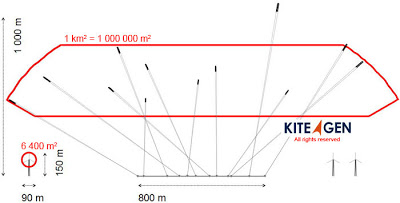

The radical italian Kitegen wind power system appears to have funding of 15 million euro (announced not distributed). An interesting synergy is possible with large Kitegen systems and nuclear power plants. Kitegen systems could be co-located with nuclear power plants to help prevent any illegal airplanes from hitting the nuclear plant. (Kite flying would be adjusted to entangle any planes or UAVs that venture into what is a no-fly zone). Meanwhile the extra power generation would be going along the existing built up power grid to the nuclear plant.
UPDATE: the funding has been announced but has not been provided yet as per Italian Technologist commenter Carlo Perassi.
For medium-to-large-scale energy generators, an alternative KiteGen configuration is being studied, namely, the carousel configuration. In this configuration several airfoils are controlled by their KSUs placed on the arms of a vertical-axis rotor. The controller of each kite is designed to maximize the torque exerted on the rotor, which transmits its motion to an electric generator. For a given wind direction, each airfoil can produce energy for about 300◦ of carousel rotation; only a small fraction (about 1%, see the “Simulation Results” section of the IEEE paper for details) of the generated energy is used to drag the kite against the wind for the remaining 60◦. According to our simulation results, it is estimated that the required land usage for a kite generator may be lower than a current wind farm of the same power by a factor of up to 30–50. Electric energy production costs lower by a factor up to 10–20.
At present, a small scale yo-yo prototype has been realized. This system can generate up to 40 kW using commercial kites with characteristic area up to 10 m2 and line length up to 800 m. The prototype is under test. Preliminary tests show that the amount of energy predicted by simulation is confirmed by experimental data.
A new KiteGen prototype is expected to be built in the next 24–36 months to demonstrate the energy-generation capabilities of the carousel configuration. In particular, a carousel structure with a single kite steering unit mounted on a cart riding on a circular rail will be considered. To collect the energy produced by the wagon motion, the wheels of the cart are connected to an alternator. Such a prototype is expected to produce about 0.5 MW with a rail radius of about 300 m. According to scalability, a platoon of carts, each one equipped with a kite steering unit, can be mounted on the rail to obtain a more effective wind power plant. This configuration can generate, on the basis of preliminary computations, about 100 MW at a production cost of about 20 €/MWh, which is two to three times lower than from fossil sources.
A standard 2-MW wind turbine has a mean production of 4000 MWh/year. To attain a mean generation of 9 TWh/year, which corresponds to almost 1000-MW mean power, 2250 such towers are required, with a land usage of 300 km2 and an energy production cost of about 100–120 €/MWh. In comparison, the production cost from fossil sources (gas, oil) is about 60–70 €/MWh. Simulation results show that a KiteGen capable of generating the same mean energy can be realized using 60–70 airfoils of about 500 m2, rotating in a carousel configuration of 1500-m radius and flying up to 800 m. The resulting land usage is 8 km^2, and the energy production cost is estimated to be about 10–15 €/MWh.
Kitegen has been covered before at Nextbigfuture A 100 MW Kitegen power plant is estimated to deliver a cost of energy produced lower than 0.03 Euro per kWh.
Note: this article is using a translation of a webpage that was in Italian.
From translation: To june the 2006 kitegen it has received a financing of 15 million euro.
The wind at high altitude (500-600 meters height) is nearly always present and blows 7000 hours during the year while that at ground level wind is present only for approximately 1700-1800 hours per year (hours that represent the Kwh relationship produced in a year regarding the power of the wind turbine generator), a year have 8760 hours.
A Kitegen system able to deliver 1 GigaWatt is projected to cost 80 million euro.
Using the first 4 million euro a 1 megawatt prototype kitegen will be built. The remaining 11 million euro of the public contribution will be used for a 20 Megawatt version. It will be constructed on the old nuclear reactor site at Trino (VC). The area is ideal because already it is protected by a “no fly zone”, will be dealt, in this case, of Aeolic of high quota. In any case, it is believed that the technology of the generators to vertical axis, when mature, will supplant that to horizontal axis, as of the rest it is already, partially, happening.
FURTHER READING
The Kitegen site has research papers and more information.
Nextbigfuture has a section with Kitegen articles.

Brian Wang is a Futurist Thought Leader and a popular Science blogger with 1 million readers per month. His blog Nextbigfuture.com is ranked #1 Science News Blog. It covers many disruptive technology and trends including Space, Robotics, Artificial Intelligence, Medicine, Anti-aging Biotechnology, and Nanotechnology.
Known for identifying cutting edge technologies, he is currently a Co-Founder of a startup and fundraiser for high potential early-stage companies. He is the Head of Research for Allocations for deep technology investments and an Angel Investor at Space Angels.
A frequent speaker at corporations, he has been a TEDx speaker, a Singularity University speaker and guest at numerous interviews for radio and podcasts. He is open to public speaking and advising engagements.



